ESA, NASA’s New System To Monitor Air Pollution Hourly From Space

KEY POINTS
- NASA, ESA and South Korea are establishing a system for monitoring air quality
- The new system can provide hourly measurements of air quality from space
- The system involves launching instruments mounted on satellites
NASA, the European Space Agency (ESA) and South Korea have teamed up to launch a new constellation of satellite-mounted instruments designed to monitor pollution from space. According to NASA, the project will enable agencies to monitor and track Earth’s air quality every hour.
The wide-scale project was kicked off by the launch of South Korea’s Geostationary Environment Monitoring Spectrometer (GEMS) last month. The instrument was deployed via the launch of the country’s ocean-monitoring satellite.
NASA intends to follow South Korea’s path by its own similar instruments in 2022. It will be mounted on a commercial communications satellite. Likewise, the ESA will also join the initiative with the launch of its own satellites and instruments in 2023.
Once the instruments have been deployed in low-Earth orbit, they will be able to establish a virtual network that can accurately monitor the air quality on every part of the globe. As noted by Barry Lefer, the program manager for NASA’s Earth Science Division, data collected by the instruments can be used to provide precise predictions regarding air quality.
“What’s exciting is getting these pollution sources and pollution transport at different times of the day,” he stated in a press briefing according to The Verge. “We’ll be able to get more accurate air quality, air pollution forecasts because we’ll know about the sources and how these sources change over time.”
Once completed, the initiative will serve as a huge improvement over the old-generation instruments currently being used to monitor pollution. Although these older systems still function properly, they can only measure air quality and pollution once a day.
Through the new project initiated by South Korea’s GEMS, environmental scientists will be able to collect accurate data through hourly measurements of Earth’s air quality.
According to the ESA principal investigator Ben Veihelmann, the information that will be gathered through the new project will benefit anyone who is interested in the environment.
“The recipient of the service and the information about the pollution ranges from the person in the street interested in how the pollution level will be this afternoon to the policymaker who is interested in trends and in the compliance of pollution levels with agreed standards,” he stated during the press briefing.
© Copyright IBTimes 2025. All rights reserved.





















